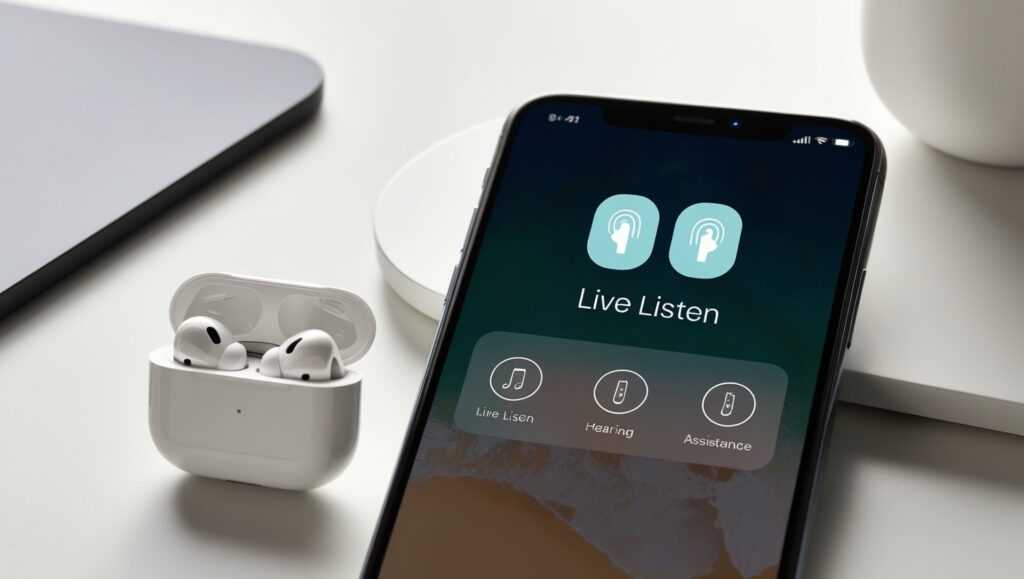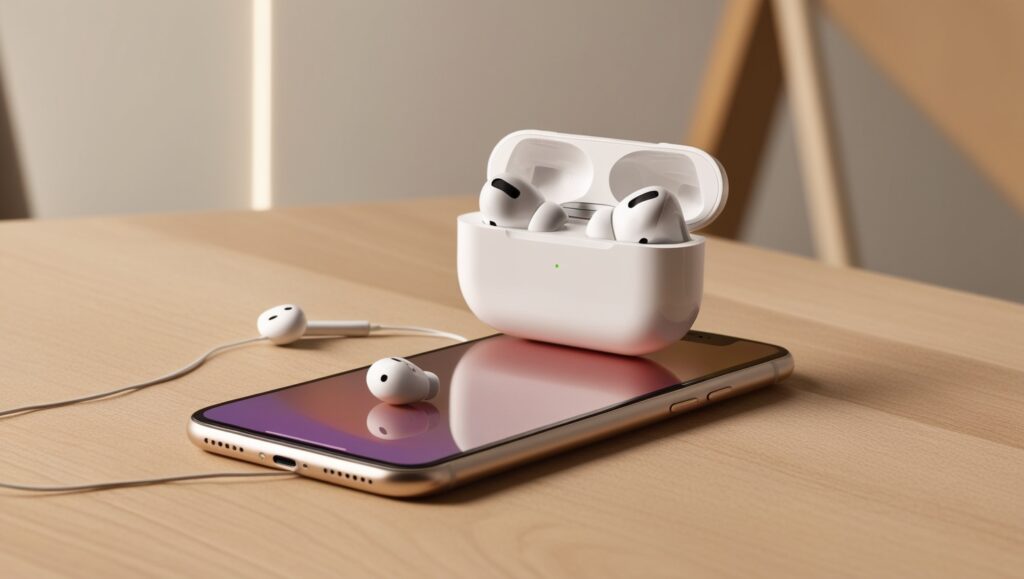In recent years, technology has significantly advanced, offering innovative solutions to everyday challenges. One such development is the ability to use Apple AirPods as makeshift hearing aids.
This feature, known as Live Listen, allows users to amplify surrounding sounds, enhancing their auditory experience in various environments. This article provides a comprehensive guide on how to utilize AirPods as hearing aids, including setup instructions, best practices, limitations, and frequently asked questions.
What is the Live Listen Feature on AirPods?
Live Listen is an accessibility feature introduced by Apple that transforms your iPhone or iPad into a remote microphone, transmitting sound directly to your AirPods. This functionality is particularly beneficial in situations where hearing is challenging, such as in noisy environments or during conversations from a distance.
Benefits of Live Listen
- Enhanced Hearing in Noisy Environments: By placing your iPhone closer to the sound source, Live Listen helps you hear conversations more clearly amidst background noise.
- Assistance in Group Settings: It aids in focusing on specific voices during meetings or social gatherings.
- Cost-Effective Solution: For individuals with mild hearing difficulties, it offers an affordable alternative to traditional hearing aids.

Tips for Ensuring Comfort with Long-Term Use
Since AirPods aren’t specifically designed for hearing assistance, keeping a few comfort tips in mind can enhance your experience, especially if you plan on using Live Listen frequently:
- Take Listening Breaks: Unlike traditional hearing aids, AirPods don’t allow for airflow, which can lead to discomfort if worn continuously. Taking periodic breaks can reduce ear fatigue.
- Use Accessories for Fit: If your AirPods don’t fit snugly, consider ear hooks or grips. These accessories can secure the AirPods more comfortably, enhancing sound capture and preventing them from falling out during use.
Compatibility Check
Live Listen is compatible with the following devices:
- AirPods Models: AirPods (2nd generation and later), AirPods Pro, and AirPods Max.
- iOS Devices: iPhone or iPad running iOS 14.3 or later.
Ensure your devices are updated to the latest software version to access this feature.
How to Set Up AirPods as a Hearing Aid Using Live Listen
Transforming your AirPods into a hearing aid involves a few straightforward steps:
Step 1: Connecting Your AirPods to iPhone
- Enable Bluetooth: On your iPhone, navigate to Settings > Bluetooth and toggle it on.
- Pair AirPods: Open the AirPods case near your iPhone and follow the on-screen instructions to connect.
Step 2: Enabling Live Listen Feature
- Add Live Listen to Control Center:
- Go to Settings > Control Center.
- Tap the “+” icon next to “Hearing” to add it.
- Activate Live Listen:
- Open Control Center by swiping down from the top-right corner of the screen.
- Tap the ear icon (Hearing).
- Select “Live Listen” to turn it on.
Step 3: Adjusting Volume and Sound Settings
- Volume Control: Use the volume buttons on your iPhone to adjust the amplification level.
- Optimal Placement: Place your iPhone near the sound source for better clarity.
Best Practices for Using AirPods as Hearing Aids
To maximize the effectiveness of Live Listen, consider the following tips:
Positioning for Optimal Sound
- Proximity: Keep your iPhone close to the person or sound source you wish to hear.
- Orientation: Ensure the iPhone’s microphone is directed towards the sound source.
Adjusting Volume Responsibly
- Avoid High Volumes: Set the volume at a comfortable level to prevent potential hearing damage.
- Monitor Sound Levels: Be mindful of sudden loud noises that may be amplified.
Battery Conservation Tips
- Charge Devices Fully: Ensure both your iPhone and AirPods are adequately charged before extended use.
- Disable When Not in Use: Turn off Live Listen when it’s not needed to conserve battery life.

Limitations of Using AirPods as a Hearing Aid
While Live Listen offers valuable assistance, it’s essential to be aware of its limitations:
Sound Quality Limitations
- Not a Replacement for Hearing Aids: AirPods are not designed to replace professional hearing aids and may not provide the same level of sound quality or customization.
Battery Drain
- Increased Consumption: Using Live Listen can drain the battery of both your iPhone and AirPods more quickly.
Environmental Challenges
- Background Noise: In extremely noisy environments, Live Listen may amplify unwanted sounds, making it less effective.
- Distance Limitations: The effectiveness diminishes as the distance between the iPhone and the sound source increases.
Alternative Apps and Accessories for Hearing Assistance
If you’re seeking additional hearing support, consider the following options:
Apps That Enhance Hearing on AirPods
- Petralex Hearing Aid: An app that turns your iPhone into a hearing aid, offering customizable sound amplification.
- Hear Boost: Provides real-time sound enhancement and noise reduction features.
Other Apple Devices for Hearing Support
- AirPods Pro and AirPods Max: These models offer advanced features like Transparency Mode, which allows you to hear ambient sounds more clearly.
Accessories for Enhanced Listening
- Ear Hooks: Accessories that secure AirPods in place, ensuring optimal positioning for sound capture.
- External Microphones: Connecting an external microphone to your iPhone can improve sound quality when using Live Listen.
Conclusion
Using AirPods as a hearing aid can be a simple and cost-effective solution for individuals with mild hearing difficulties. Thanks to Apple’s Live Listen feature, AirPods become more than just wireless earbuds—they offer practical support for everyday listening challenges. While they don’t match the full capabilities of dedicated hearing aids, they do provide a level of sound amplification that can be helpful in many scenarios, like attending meetings, enjoying conversations in bustling spaces, or even listening more clearly to media in a busy home.
However, it’s essential to understand that Live Listen and AirPods are not a substitute for professional hearing aids. Unlike hearing aids that are customized and calibrated to an individual’s specific hearing needs, AirPods lack advanced features like noise cancellation, feedback control, and customizable frequency adjustments. Additionally, the battery life may not sustain prolonged listening sessions if Live Listen is used continuously.
For those experiencing moderate to severe hearing loss, relying on AirPods alone isn’t ideal. Professional hearing aids are designed to be worn for extended periods without discomfort and are built with durability and efficiency in mind for daily use. Therefore, AirPods can act as a supplemental tool for improved hearing but should not replace professional treatment for hearing health.
Frequently Asked Questions
1. Can AirPods fully replace a traditional hearing aid?
No, AirPods are not designed to replace professional hearing aids. They can assist with mild hearing difficulties but lack the customization and advanced features of dedicated hearing aids.
2. Does Live Listen work on all AirPods models?
Live Listen is compatible with AirPods (2nd generation and later), AirPods Pro, and AirPods Max when paired with an iPhone or iPad running iOS 14.3 or later.
3. How can I adjust sound settings for better hearing with AirPods?
You can adjust the volume using your iPhone’s controls. Additionally, ensure your iPhone is positioned close to the sound source and that Live Listen is enabled in the Control Center.
4. Are there alternatives to AirPods for hearing assistance?
Yes, there are apps like Petralex Hearing Aid and Hear Boost that enhance hearing capabilities. Additionally, devices like AirPods Pro and AirPods Max offer features such as Transparency Mode for improved hearing support.
5. Is using AirPods as a hearing aid safe for extended use?
While using AirPods with Live Listen can be beneficial for short-term hearing assistance, they are not designed for prolonged use as hearing aids. Extended use at high volumes may lead to hearing fatigue or damage. It’s advisable to consult with a hearing healthcare professional for long-term solutions.
6. Can Live Listen work through walls or at long distances?
No, Live Listen is limited by the range of Bluetooth, which usually extends up to about 30 feet in open spaces. However, walls and obstacles can reduce this range. Keeping the iPhone within line-of-sight or close proximity to the AirPods ensures the best connection and sound quality.
7. Is there any way to reduce background noise while using Live Listen?
While AirPods don’t have the advanced noise-canceling technology of some hearing aids, positioning the iPhone directly near the primary sound source can help minimize background interference. Additionally, some users find that adjusting the volume and experimenting with different placements can yield better clarity.
8. How does AirPods’ battery life compare when using Live Listen?
Using Live Listen can impact battery life significantly because the feature continuously streams sound from the iPhone to the AirPods. While AirPods Pro or AirPods Max may have slightly longer battery life due to their size and design, it’s recommended to keep the AirPods charged and use Live Listen only when necessary.
9. Are there alternatives if AirPods are uncomfortable for extended hearing aid use?
For those who find AirPods uncomfortable for extended wear, over-the-ear headphones like AirPods Max can be a better option, offering increased comfort and features like Transparency Mode. Transparency Mode allows ambient sound in while also providing hearing assistance, creating a more natural listening experience in various environments.